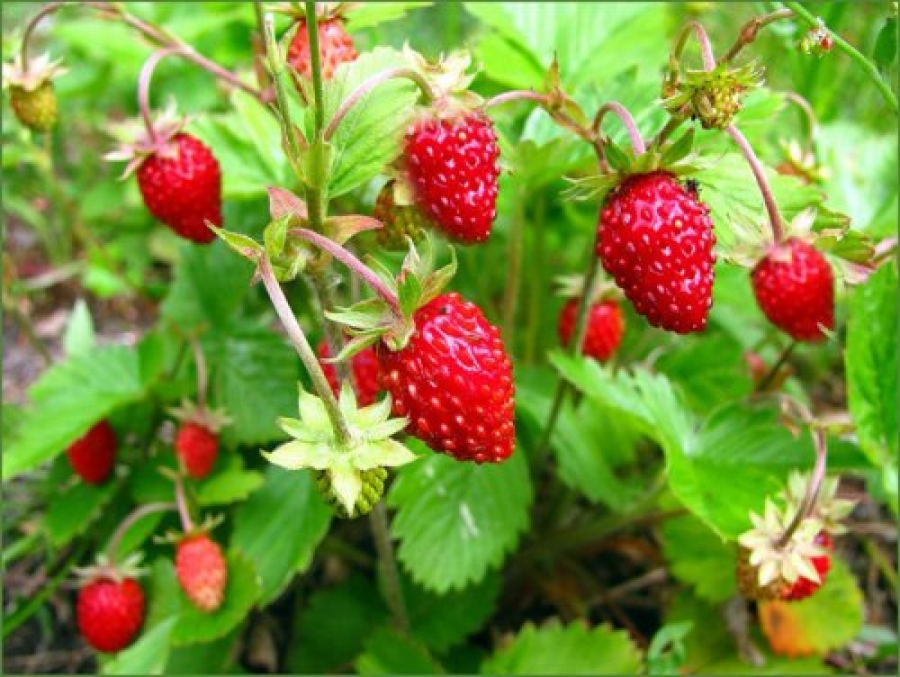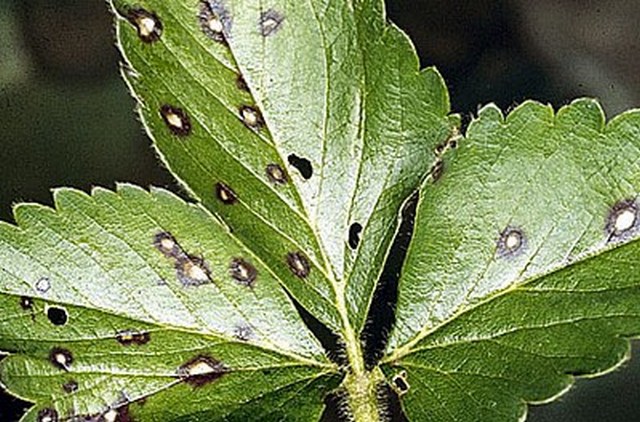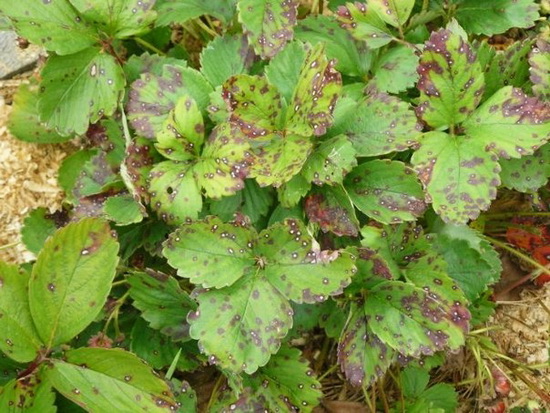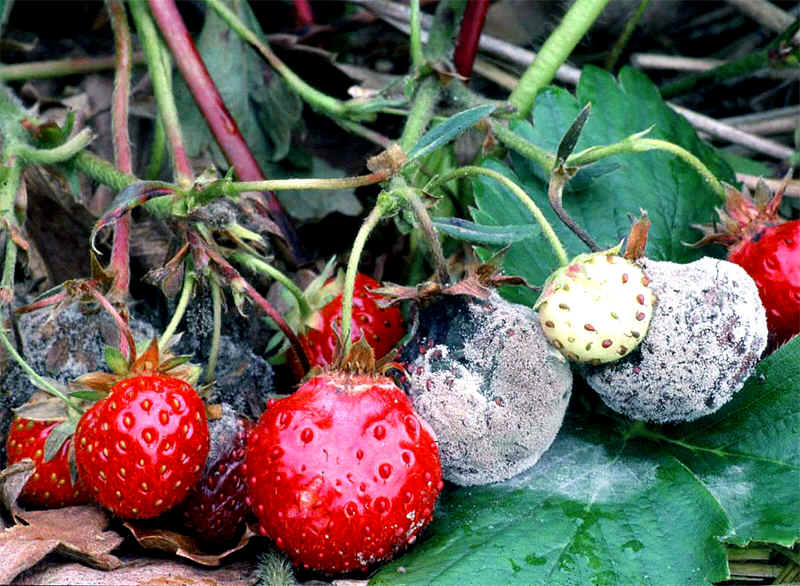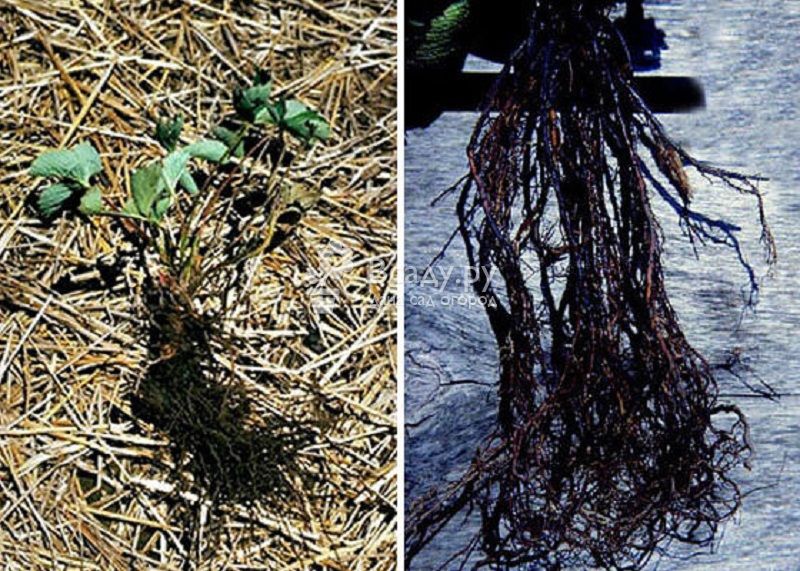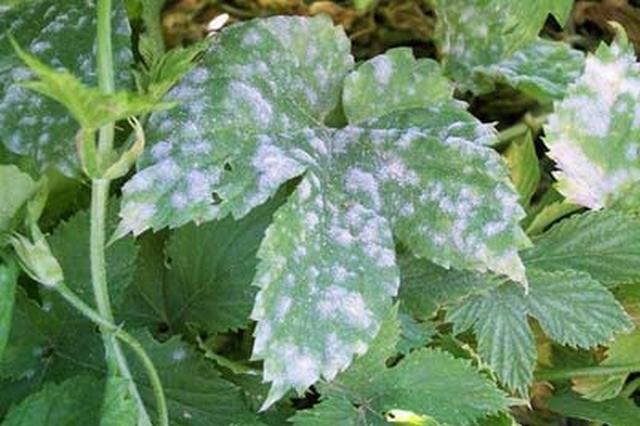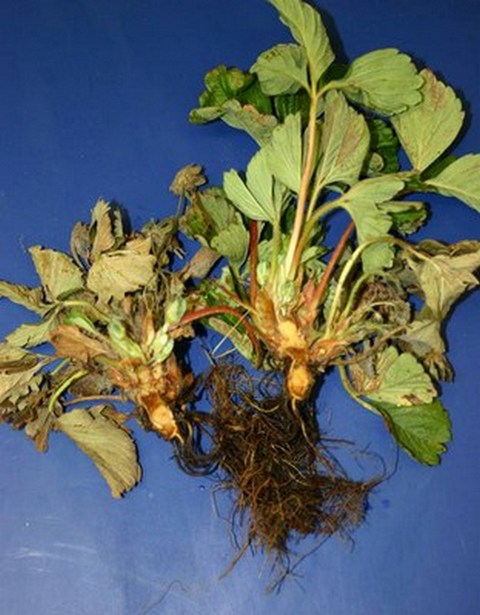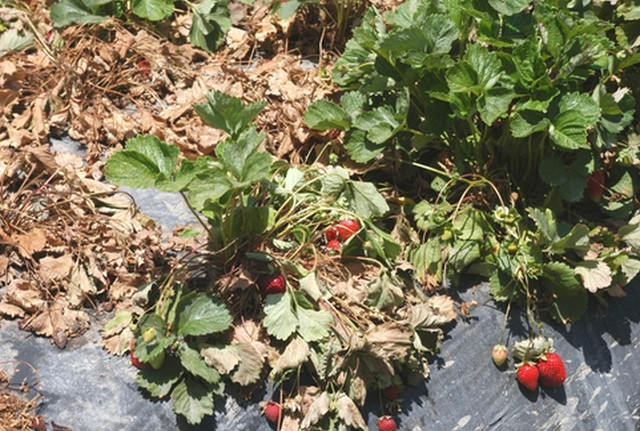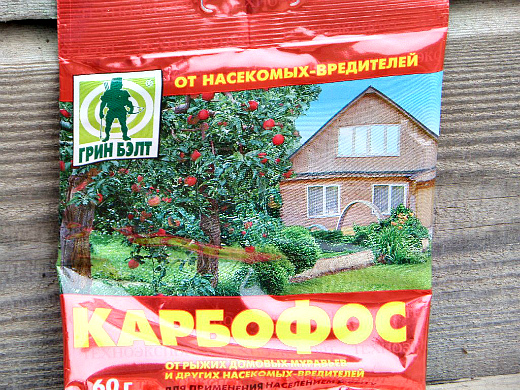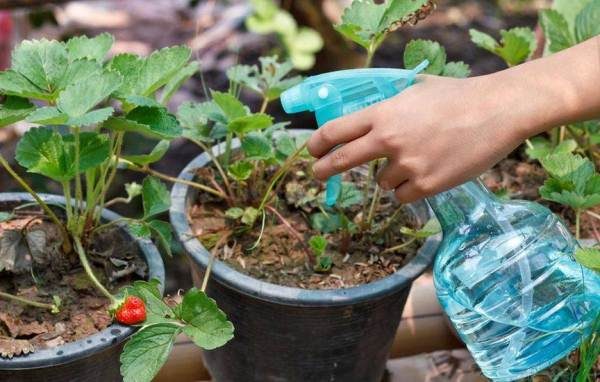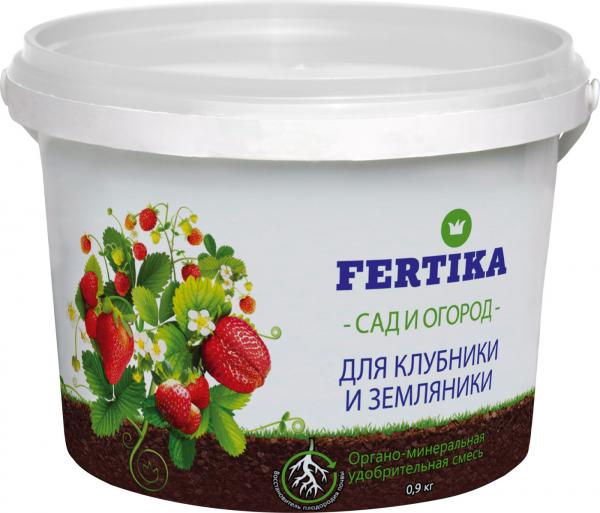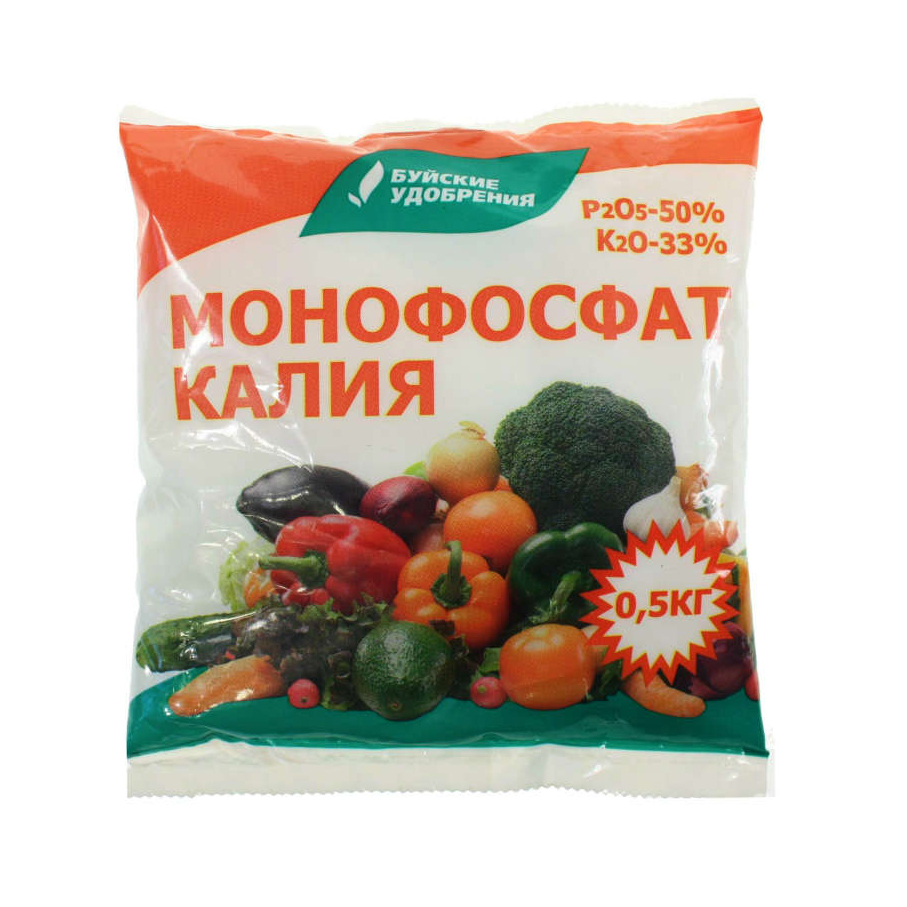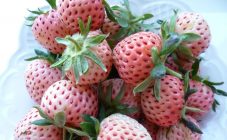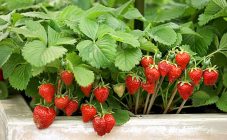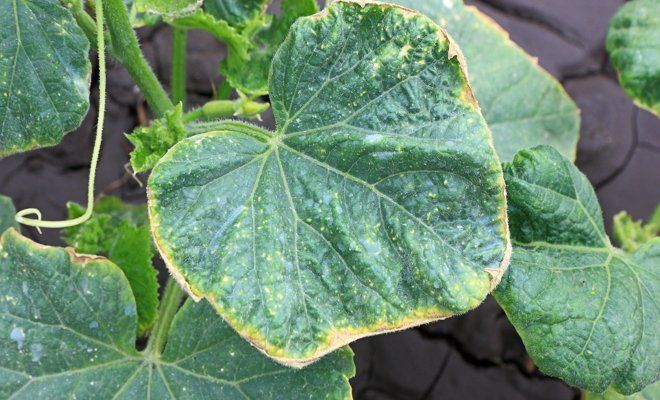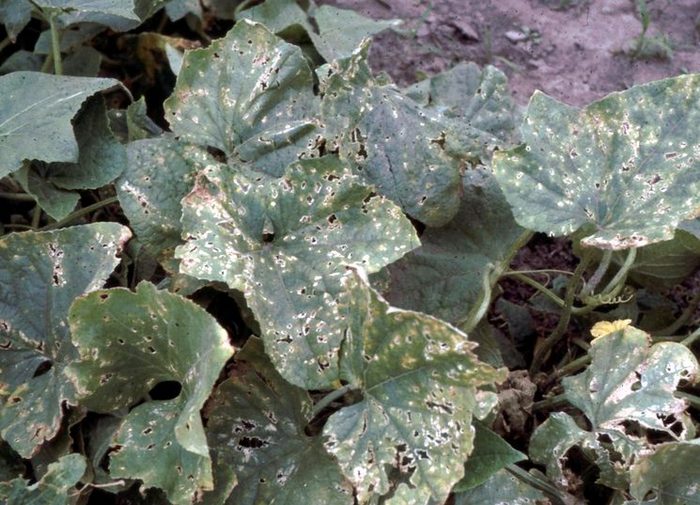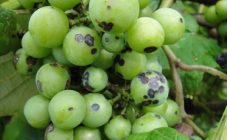Content:
Garden strawberries are popular with summer residents. Not only gardeners, but also breeders are engaged in its cultivation. The varietal variety of strawberries is impressive. The berries are characterized by:
- aroma and sweetness;
- long shelf life;
- frost resistance;
- the duration of fruiting.
However, all plant varieties have a disadvantage: susceptibility to diseases and pests of strawberries to one degree or another.
Diseases of garden strawberries
The predisposition of garden strawberries to fungal infections is noted. The situation aggravates during the period of rains, temperature jumps, if it is cloudy, damp, and there is no sun outside. The fungus settles on strawberry greens, fruits and even in the roots.
Leaf blight
Refers to a widespread ailment. Warm meteorological conditions are a catalyst for the active development of strawberry white spot. The foliage begins to dry out en masse, causing a decrease in yield.
Symptoms: white spots without a border appear on young leaves, whitish spots with a purple edging appear on old leaves.
How to fight
They are processed by means of:
- the formation of inflorescences;
- branch of buds;
- after harvesting berries.
Brown foliage
The development of the disease refers to the middle of the summer season on old foliage in the form of fuzzy spots. Infected leaves look like dried ones. The disease negatively affects the next harvest, sometimes leading to the rapid death of strawberry plantations.
Symptoms: covering of leaves and sepals with purple spots that slowly merge and turn brown, the leaf turns yellow and dies imperceptibly.
How to fight
- Use drugs for the ejection of peduncles, the formation of buds, fruit collection.
- Late autumn and with the arrival of spring, dried and affected leaves are removed.
- Mulch the soil, prevent waterlogging.
- Eliminate harmful insects - carriers of diseases, especially spider mites.
- They make potassium-phosphorus feed, they are not carried away by nitrogen fertilizers.
- After harvesting, they are treated with Fitosporin.
Gray rot
Fungal infection of strawberries can affect and destroy up to 80% of berry products.
Symptoms: on the berries, non-softened spots of pale brownish and gray color with a fluffy bloom are formed, which quickly spread. Fruits dry out and mummify gradually. By this time, the strawberry foliage is covered with extensive spots of brownish or dark gray color, the pedicel and ovaries dry out.
How to fight
The following measures are taken:
- Before the berries ripen, mulch is introduced into the rows between the plants - straw or pine needles.
- Observe the crop rotation. Strawberries are planted on old beds at least 7 years later - pests live in the ground for a long time.
- Strawberry bushes are surrounded by grooves that are filled with lime.
- Affected strawberries must be immediately dug up and destroyed.
White rot
Cause of occurrence:
- lack of heat and light;
- excess moisture.
Symptoms: the appearance of whitish spots on strawberry foliage - rot. Then the spots spread to the berries, which turn white and are affected by the fungus.
Black fruit rot
The manifestation of infection is generated by heat and high humidity, which are typical for fruits.
Symptoms:
- brown color of berries;
- loss of aroma;
- wateriness;
- the appearance of black plaque.
How do they fight
The disease does not respond to treatment. Infected fruits are removed and burned.
Planting strawberry seedlings in a high area (15-40 cm above the ground).
Watering strawberry bushes with potassium permanganate to disinfect the soil and improve the quality of berries - 2 g of the drug per 10 liters of water.
Reducing the amount of fertilizing with nitrogen and organic matter.
Root rot
It occurs on young roots. Black spots gradually grow and merge. As a result, the bush becomes infected. The yield is reduced.
Symptoms:
- the strawberry bush turns brown from the roots to the outlet;
- fragility, fragility, lifelessness of the root system;
- dying off of the root and foliage of the lower layer in July and August.
How to fight
The disease is not treated. Diseased plants are removed and burned. The soil is treated with disinfectants.
Preventive actions:
- Feeding strawberries only with rotted compost - not rotted feeding contains pathogenic microorganisms.
- After the snow melts, the bushes are sprayed with a fungicide.
- Processing by Phytodoctor is carried out after sheltering the strawberries for the winter season.
- For planting garden strawberries, only beds illuminated by the sun, without stagnant water, are suitable.
The most common herbal diseases
Powdery mildew
A fungal infection damages the ground parts of strawberries: foliage, berries, and reduces yields. The disease is stimulated by increased air temperature and humidity.
Symptoms:
- whitish spots are formed from the inside of the leaves, which resemble plaque;
- spots grow and turn into one whole;
- twisted leaves wrinkle and thicken;
- the ovaries stop growing, acquire a brown tint and fall off;
- a white bloom appears on the formed fruits, the berries turn blue and rot;
- strawberry antennae turn brown and die off.
When garden strawberries are affected, diseases and pests are not ignored. Powdery mildew is fought with the following methods:
- strawberries are treated with an emulsion before flowering and after harvesting berries, it includes soap (30 g), water (15 l), Topaz (15 g), as well as 30 g each of copper sulfate and azocene;
- when pouring and ripening the fruits, processing is carried out, in which milk whey is diluted in water in a ratio of 1:10;
- if the situation worsens, a couple of drops of iodine are mixed with the serum and regularly processed after 3 days.
Prevention:
- before planting strawberries, copper sulfate is suitable for processing the root system;
- Topaz is used before the strawberry blossoms
- mineral fertilizers are appropriate for spraying foliage;
- recovered bushes are sprayed with soda ash;
- leaves from affected bushes of strawberries are removed and burned;
- 3 years later, another site is prepared for seedlings, which is removed from the infected plantings, the soil is disinfected with potassium permanganate.
Late blight
Fungal infections are dangerous diseases of strawberries. These include late blight rot, which can completely ruin the harvest.
With late blight of strawberries, the bush becomes infected, but the first manifestations are noticed on the berries.
Other symptoms include:
- thickening of the berry skin;
- harshness of the pulp and bitter aftertaste;
- the appearance of dark purple spots and drying of the fruit;
- drying of the foliage and stem of the strawberry bush.
Incorrect watering gives rise to late blight: an excess of moisture is the optimal environment for the reproduction of the fungus.The infection remains in the soil for a long time, on the affected plant. Compliance with agrotechnical practices is appreciated.
When strawberries are ill with late blight, measures are taken to combat it:
- Ripe berries are harvested, not forgetting to remove diseased fruits, dried leaves, unnecessary tendrils, thinning bushes.
- Strawberries are not fed.
- Between plantings of different varieties of strawberries, they maintain a distance of at least 2 m.
- 30x25 cm is the optimal pattern for planting strawberries, which is required for airing and lighting.
- Change the planting material every 3 years or more often.
Fusarium
The reasons that provoke fusarium include hot weather and weedy beds.
Symptoms:
- necrosis along the border of the leaves;
- the acquisition of brown strawberry bushes and the speed of drying;
- all parts of the plant are affected.
Treatment of fusarium is possible at an early stage of the disease. Fungicides are the best way to treat strawberries in the spring against diseases and pests.
Prevention:
- choice for planting only healthy seedlings;
- compliance with crop rotation;
- timely weeding;
- before planting, strawberry roots are soaked in biological products: Agata-25K (for 1 liter of 7 g) and Humate K (for 1 liter of 15 g);
- the infected strawberries are eliminated.
Anthracnose
Another name for the disease is black spot. The fungus completely affects the strawberry bush. The development of the disease is accompanied by rainy weather in spring or early summer at high temperatures. Fungal spores are introduced to the site by:
- soil;
- seedlings;
- shoes;
- mechanisms.
Symptoms:
- the appearance of red leaves on strawberries, then cracking and drying;
- covering shoots and stems with ulcers, which have a light middle and a dark border;
- dying off of the stem and drying out of the bush.
If strawberries ripen, the fungus appears as watery spots that later darken. It is forbidden to feast on such berries. When on immature fruits, depressed spots of a dark color are found, we are talking about the wintering place of the fungus.
The complex fight against anthracnose involves the use of fungicides:
- Fundazole;
- Horus;
- Trichodermina.
Just right to treat strawberries in the spring from diseases and pests with Bordeaux liquid. Strawberries are sprayed with this remedy for preventive purposes, carried out three times during the growing season, sulfur is added to the solution.
Pest control
Karbofos: instructions for use in the garden for strawberries
They note the effectiveness of the universal drug in the battle against ticks and weevils - the main enemies of strawberries. Berry plantings are sprayed in the spring until the mass emergence of pests to the surface, if the soil temperature is + 8 ° C, and buds are formed.
A tick-off treatment involves watering each strawberry bush in August or September after harvesting and clearing dried foliage from the strawberry plantation. After manipulation, the site is covered for 12 hours. The working solution of Karbofos, according to the instructions for use in the strawberry garden, is prepared from 60 g of the drug, which are dissolved in 8 liters of water.
Fitoverm for strawberries: instructions for use
Belongs to biologics of the 4th generation. The use of Fitoverm is effective in confronting the weevil on strawberries. They fight the beetle until the berry bushes bloom, and before the fall season.
Distinctive features of Fitoverma:
- has an intestinal contact effect, causes paralysis of the nervous system and death of parasites;
- safe for the environment, quickly degrades in soil and water;
- productive in hot conditions;
- acts in a greenhouse after 6-8 hours after processing, in an open area - after 8-16 hours;
- protects crops in greenhouses for 1-3 weeks after application, in open beds - depending on weather conditions, for 5-15 days;
- not toxic to strawberries.
Apply in the following way:
- spider mite - 1 ampoule for 1 liter of water;
- thrips - 1 ampoule for 0.2 l of water;
- aphid - 1 ampoule for 0.25 l of water.
They are processed 4 times with a break a week.
Fertika for strawberries and strawberries
It is a mixture that consists of humate (18%) and a complex of macro- and microelements. Fertica for strawberries and strawberries is introduced at the root or processed on the leaves. Produced in a factory container of 0.9 kg.
In order for garden strawberries to delight with large-fruited berries, bushes are fed in middle Russian latitudes from April to early summer, in the south of the country - in January and February. If it is planned to spray the strawberry plantations with Fertika, the consumption rate is 30 g per 10 liters of water. During the season, strawberries are processed 3 times (per 1 m2 50 g), when planting seedlings - 15 g per hole.
Monopotassium phosphate: application for strawberries and strawberries
Mineral dressing is suitable for feeding plants in protected and open ground. Potassium-phosphorus fertilizer is applied as root or foliar top dressing.
After harvesting, strawberries and strawberries are prepared for wintering, watered with monopotassium phosphate: 10 g per 10-liter bucket of water. The dosage for 1 bush is 0.5 l.
Preventive measures
To preserve strawberry plantings for 3-4 years and get a good harvest, follow the rules:
- after harvesting, diseased bushes, excess mustache and leaves are eliminated;
- feeding strawberry plantings on time;
- before the beginning of the winter period, treatment with Topaz, Euparen, Switch is carried out;
- for planting, varieties that are not genetically susceptible to diseases are used;
- do not forget about periodic weeding in the care;
- pollination with wood ash of strawberries prevents the development of spring diseases: for 1 m2 70 g. Garlic tincture protects against fungus: 0.5 kg of crushed garlic is mixed with 10 liters of water. After 3 days, it is filtered through a bandage, diluted in a 1: 1 ratio. For viral and fungal infections, strawberries are sprayed with an iodine solution (10 ml of water per 10 l of water), as well as three times with ammonia: once in early spring - 40 ml per 10 l of water; 2 times - 3 tbsp. l. for 10 liters of liquid after flowering, 3 watering after berries ripening is identical to the first treatment.
Biofungicide treatment and yield
If diseases prevail on garden strawberries, they resort to biological products. They are indispensable for protecting against fungi and bacteria. Biofungicides are especially effective against fungal infections, safe for livestock and humans.
The advantage of the drug is that there is no waiting period. Harvesting is carried out without waiting 14 days after processing. The timing of fruit ripening and the need for harvesting every 2 days allow the preservation of a significant part of the berries.
Trichodermin, as well as Tioplant, are actively used throughout the growing season at their summer cottage for the improvement of strawberry bushes and soil.
Acquaintance with the description of the symptoms of diseases, methods of combating pests and ailments, as well as their prevention will help gardeners take adequate measures to obtain a generous harvest.
